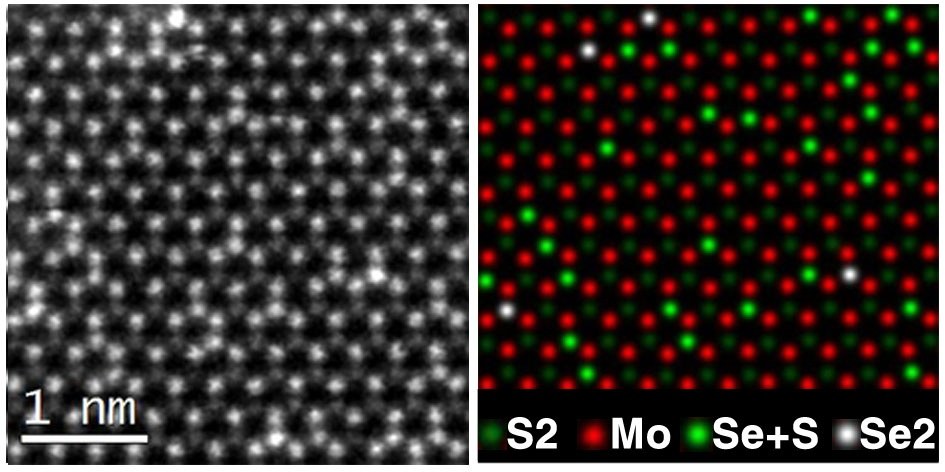The last thing we want to discuss for atomic masses is how can we determine the abundance of an isotope.
Abundance?
We have already said that abundance indicates how many atoms of a particular isotope we'll get if we randomly grab 100 atoms of an element. What we haven't said is that how can we identify and count atoms of a specific isotope which are mixed with atoms of other isotopes.
Can we do that by looking at the atoms? Maybe in the future we can, but not now. If we look at an atom under very powerful microscope (which uses electron beams rather than visible light to attain very high resolution), we can see some small dots, just like the one below.
However, due to limitations of technology, we can not see the neutrons inside the atoms yet. Therefore, we can not decide what isotope the atom belongs to.
So how do we differentiate atoms of different isotopes then?
Mass is the answer
Have you tried to throw a basket ball? How far can you throw it? How about a shot put, how far can you do it? If you apply the same force for throwing a basket ball and a shot put, you may probably see the basket ball will go a longer distance because it is lighter.
The same thing we're going to do here. Since atoms of different isotopes have different mass, we can try pushing them with the same force, and the lighter ones will move further while the heavier one will stay closer to us. So if we push 100 atoms of the element, we may find some of them being far away from us, and some of them quite near us. Those far from us will be one isotope while those near us are another isotope. Now we can simply count how many atoms are far and how many are near us, and we will have the abundance.
This method is named mass spectrometry.
Mass spectrometry
Mass spectrometry is an analyzing technology that uses mass difference between particles to seperate them and subsequently count them. Just like what we did just now, a mass spectrometer which is the equipment to perform mass spectrometry analysis would apply a force to push different particles and see which one moves more.
We'll take boron (\( \ce{_5B} \)) as our example, and we shall see what will be the steps required to determine the isotopes as well as their abundances using mass spectrometry.
Vaporization
The first step of mass spectrometry is to vaporize the atoms. This allows us to seperate individual atoms.
For example some elements, like boron, naturally exist in solid state. As we have learnt before, particles in solids are staying at fixed positions and they are closely packed together. This would prevent us from seperating individual atoms and therefore makes it difficult for us to identify the isotopes. There fore, we have to vaporize them so that they could become gaseous particles, which will not touch each other and are able to move around freely.
\[ \ce{B_{(s)} -> B_{(g)}}\]
Ionization
Naturally, it is very difficult for us to apply forces on atoms. They're neutral in charge, they're light in weight, and they're small in size. Traditional methods like the way we pick up a basketball, or how we use a conveyor belt can not be applied in such a situation.
Luckily, physics tells us that a charged particle could be moved using an electrical field. Positive particles will be attracted towards the negative end of the electrical field, while the negative particles attracted to the positive end.
Meanwhile, physics also tells us that when a charged particle moves in an magnetic field, it will experience a elctromagnetic force in the direction perpendicular to its direction of movement.
Now we have found methods to move a charged particle in two directions, we can use electrical field to move it, and then use magnetic field to make it off its course.
What's even more lucky is that we can easily make an atom with no charge to be charged (forming an ion).
So the second step of mass spectrometry is to ionize the atoms so that we could use electrical field and magnetic field to move it in various directions.
What exactly do we need to do to make the boron atoms charged? We could use electrons to remove electrons. Confused? Think of billiard games. You're using a "cue ball" to knock other balls into the pockets. That's exactly how electrons could knock out other electrons in boron atoms.
Basically, a beam of high speed electrons is produced and will pass through the gaseous boron atoms that we produced in the vaporization step. There is a chance that the high speed electrons could hit one of the electrons in one of the atoms, which then loses the electron and becomes positively charged.
This process could be represented by the following equation
\[ \ce{B_{(g)} + e- -> B_{(g)}+ + 2e-}\]
At the end of this step, we have a lot of boron ions with a positive 1 charge.
Do take note that it is absolutely possible that the same atom would be hit by the high speed electrons twice or even more times. As a result, boron ions with higher charges such as \( +2 \) and \( +3 \) charges could be produced. However, still considering our billiard games, the chance that the same ball being hit by the cueball multiple times would be quite low because no one is really aiming the electron beam, but rather it goes randomly towards the boron atoms. Therefore, we could just ignore those highly charged boron ions produced because the amount of these ions would be so low as compared to \( \ce{B+} \) ions.
In the next page, we'll see what to do with the boron ions and how we could seperate and identify boron ions of different isotopes.
